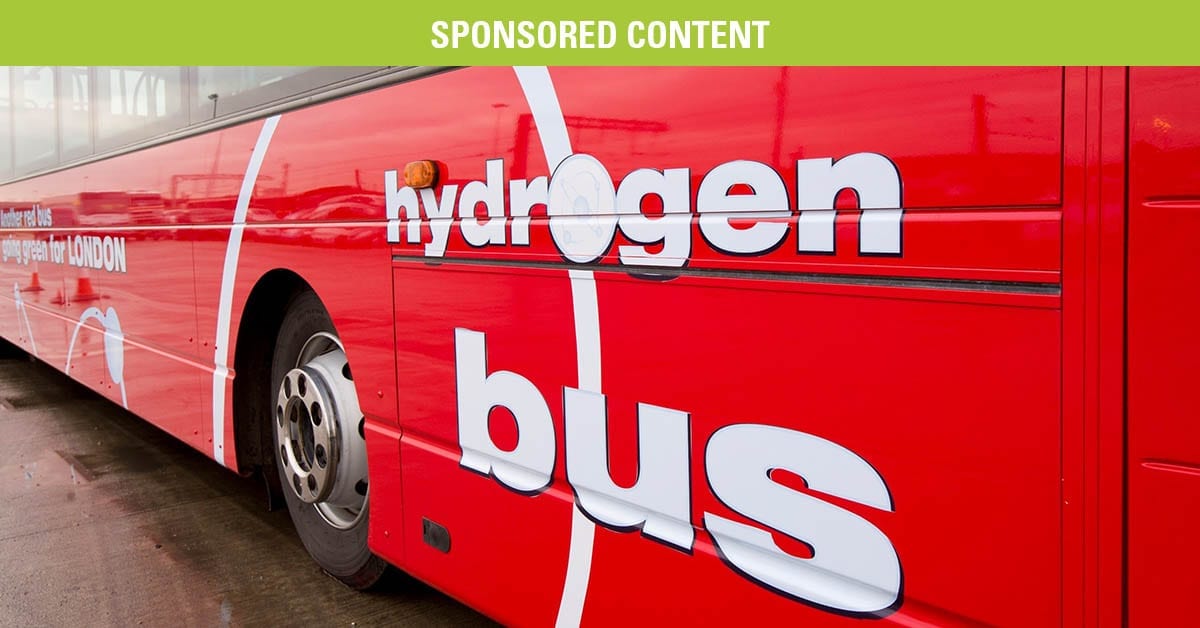By: Nicolas Pocard
Sponsored by: Ballard Power Systems

Image: Ballard Power Systems
Around the world, electric buses are providing a smooth and quiet passenger experience with zero emissions at the tailpipe. As governments and cities take the lead in placing increasingly strict regulations and restrictions on internal combustion engines, transit agencies and operators are looking at electric buses as the best option to transition their fleets to zero emissions, without affecting service levels.
Varying Electric Bus Technologies
There are several different electric bus technologies. The principal difference is how the electricity is delivered to the motor— whether through 100% battery power, or through a hybrid battery -fuel cell power train with an onboard hydrogen fuel cell “charger” as power generator — referred to as a fuel cell electric bus or FCEB.
The most popular electric bus option is currently the 100% battery bus. This electric bus option recharges batteries using either roadside fast chargers or depot overnight chargers. However, as these systems are implemented at larger scale, challenges have arisen. The challenges occur with range, route flexibility, and electric infrastructure complexity.
The fuel cell electric bus, however, addresses these challenges while also retaining the advantages of the comfortable, smooth, near-silent, zero emissions ride synonymous with an electric bus.
What is a Fuel Cell Electric Bus?
The fuel cell electric bus is a 100% electric bus with a hybrid battery-fuel cell power train. The fuel cell system acts as an onboard battery charger, using hydrogen as a high-density energy source. The fuel cell provides electricity to the electric drive and maintains the bus battery at an optimum charging level. In California, 50 fuel cell electric buses will be in operation in 2019. Today, several bus manufacturers such as New Flyer and Eldorado currently offer 40ft and 60ft fuel cell electric buses, powered by Ballard systems, as a standard option for their electric bus platform. Such buses have passed Altoona FTA testing.
Hydrogen stores twice the energy of a standard bus battery at a fraction of the weight. As a means of storing and transporting low-carbon fuel, hydrogen is an effective alternative to the electric grid.
Hydrogen as a Fuel Source
Hydrogen stores twice the energy of a standard bus battery at a fraction of the weight. As a means of storing and transporting low-carbon fuel, hydrogen is an effective alternative to the electric grid. When produced from renewable energy, hydrogen is a true zero emission fuel that also enables grid-balancing and large-scale, long-term energy storage.
Fuel cell electric buses provide the operator with zero emission transit without compromise. Some of the benefits of fuel cell electric buses include:
- Up to a 330 mile range before refueling
- Consistent power delivery during duty cycle
- Eliminated need for roadside charging infrastructure, just as with CNG
- Fast refueling — less than 10 minutes of refueling delivers 18 hours of continuous service
- Compact central fueling infrastructure at depots
- 1-to-1 replacement to conventional buses
Building an electric charging infrastructure often requires additional, unpredictable costs for upgrading power grids and facilities. Hydrogen technology, however, delivers scalable infrastructure with minimum changes to the electrical grid infrastructure and multiple, competitive options for long supply agreement.
Hydrogen technology delivers scalable infrastructure with minimum changes to the electrical grid infrastructure and multiple, competitive options for long supply agreement.
What to Know Before Going Electric
Around the world, transit systems are “going electric” and the trend is irreversible. Electric buses are the proven option for true zero emissions at tailpipe. The choice that cities and transit authorities now face, though, is how to recharge their electric buses. Should transit agencies install a roadside-opportunity charging infrastructure? A system of overnight depot chargers? Or a centralized hydrogen refueling facility?
Ultimately, cities must make these decisions based on their unique operational requirements, geography, and climate, as well as the availability and price of electricity and hydrogen and local constraints. Many cities will choose a combination of battery buses and fuel cell electric buses, which provide effective emission reduction along with fast refueling, extended range, and route flexibility for transit agencies worldwide.
About the Author:
Nicolas Pocard, Director of Marketing, Ballard Power Systems brings more than 20 years of experience in international high technology products sales and marketing. Among his responsibilities, Nicolas looks after market strategy, marketing activities, and government relations for Ballard. Nicolas Pocard is a board member of the California Hydrogen Business Council, co-chairing the Public Transit group and represents Ballard with various Industry Associations and Government forums.


